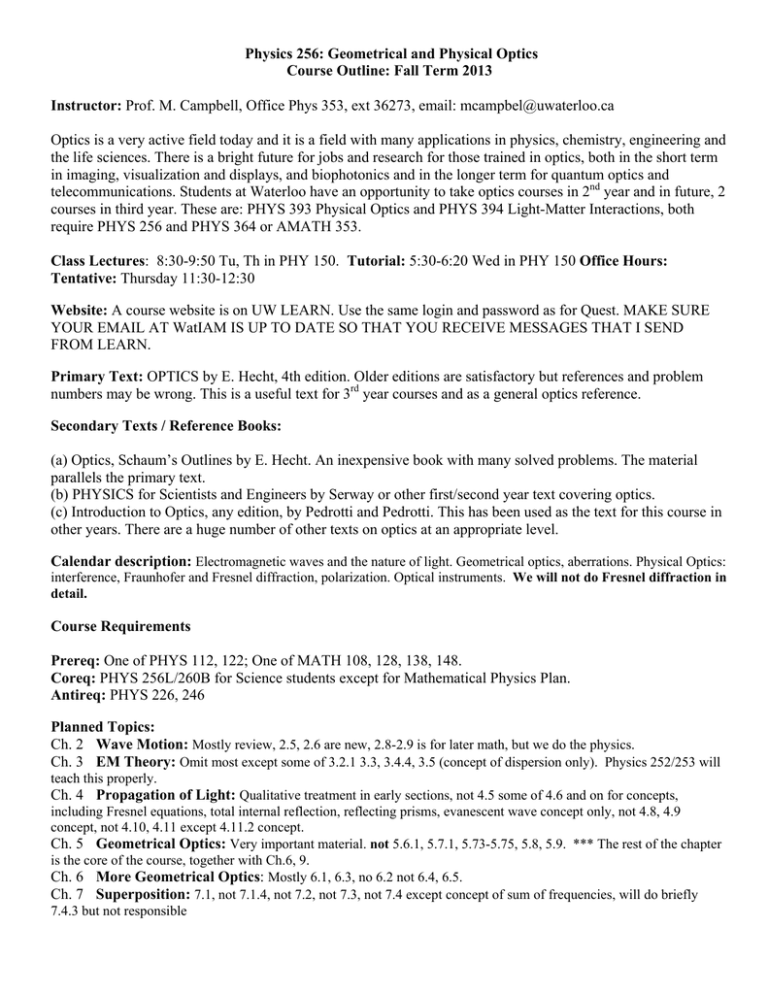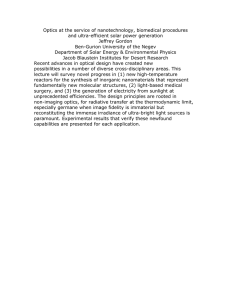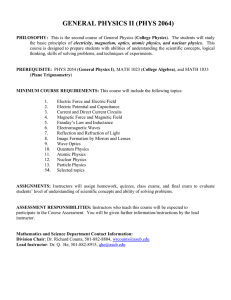Physics 256: Geometrical and Physical Optics Course Outline: Fall
advertisement

Physics 256: Geometrical and Physical Optics Course Outline: Fall Term 2013 Instructor: Prof. M. Campbell, Office Phys 353, ext 36273, email: mcampbel@uwaterloo.ca Optics is a very active field today and it is a field with many applications in physics, chemistry, engineering and the life sciences. There is a bright future for jobs and research for those trained in optics, both in the short term in imaging, visualization and displays, and biophotonics and in the longer term for quantum optics and telecommunications. Students at Waterloo have an opportunity to take optics courses in 2nd year and in future, 2 courses in third year. These are: PHYS 393 Physical Optics and PHYS 394 Light-Matter Interactions, both require PHYS 256 and PHYS 364 or AMATH 353. Class Lectures: 8:30-9:50 Tu, Th in PHY 150. Tutorial: 5:30-6:20 Wed in PHY 150 Office Hours: Tentative: Thursday 11:30-12:30 Website: A course website is on UW LEARN. Use the same login and password as for Quest. MAKE SURE YOUR EMAIL AT WatIAM IS UP TO DATE SO THAT YOU RECEIVE MESSAGES THAT I SEND FROM LEARN. Primary Text: OPTICS by E. Hecht, 4th edition. Older editions are satisfactory but references and problem numbers may be wrong. This is a useful text for 3rd year courses and as a general optics reference. Secondary Texts / Reference Books: (a) Optics, Schaum’s Outlines by E. Hecht. An inexpensive book with many solved problems. The material parallels the primary text. (b) PHYSICS for Scientists and Engineers by Serway or other first/second year text covering optics. (c) Introduction to Optics, any edition, by Pedrotti and Pedrotti. This has been used as the text for this course in other years. There are a huge number of other texts on optics at an appropriate level. Calendar description: Electromagnetic waves and the nature of light. Geometrical optics, aberrations. Physical Optics: interference, Fraunhofer and Fresnel diffraction, polarization. Optical instruments. We will not do Fresnel diffraction in detail. Course Requirements Prereq: One of PHYS 112, 122; One of MATH 108, 128, 138, 148. Coreq: PHYS 256L/260B for Science students except for Mathematical Physics Plan. Antireq: PHYS 226, 246 Planned Topics: Ch. 2 Wave Motion: Mostly review, 2.5, 2.6 are new, 2.8-2.9 is for later math, but we do the physics. Ch. 3 EM Theory: Omit most except some of 3.2.1 3.3, 3.4.4, 3.5 (concept of dispersion only). Physics 252/253 will teach this properly. Ch. 4 Propagation of Light: Qualitative treatment in early sections, not 4.5 some of 4.6 and on for concepts, including Fresnel equations, total internal reflection, reflecting prisms, evanescent wave concept only, not 4.8, 4.9 concept, not 4.10, 4.11 except 4.11.2 concept. Ch. 5 Geometrical Optics: Very important material. not 5.6.1, 5.7.1, 5.73-5.75, 5.8, 5.9. *** The rest of the chapter is the core of the course, together with Ch.6, 9. Ch. 6 More Geometrical Optics: Mostly 6.1, 6.3, no 6.2 not 6.4, 6.5. Ch. 7 Superposition: 7.1, not 7.1.4, not 7.2, not 7.3, not 7.4 except concept of sum of frequencies, will do briefly 7.4.3 but not responsible Ch. 8 Polarization: Only 8.1.1 linear polarization. And 8.6 Brewster’s angle. Ch. 9 Interference: Important material. 9.1, 9.2-only concept of temporal and spatial coherence, Not 9.2.2, 9.3 to end of equations, 9.4 no interferometers except Michelson, not 9.5, not 9.6, simplified 9.7.2 single film, not 9.8. *** The core of the course, together with Ch.5, 6. Ch.10 Diffraction: Only 10.1, 10.2.1, 10.2.5, 10.2.6- We omit some of the heavier general theory, not 10.2.7, not 10.310.5.




